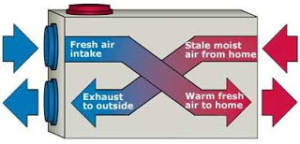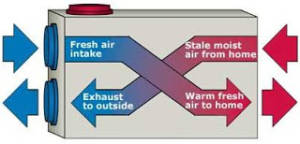In the winter, fresh air is cold air. And your home and business are built to keep the cold air out. But you can keep the air inside fresh year-round and conserve energy at the same time with the use of a heat-recovery air exchanger, also called an air-to-air heat exchanger.
An average home should have at least .35 air changes per hour (ACH). Newer, high-efficiency homes generally have ACH of less than .35, with many as low as .05, which leads to poor air quality and consequent health conditions such as headaches and allergies.
In addition to providing a fresh air supply, air exchangers help reduce allergens and unhealthy indoor air pollutants such as radon and smoke. They are required by new construction building codes in some states.
Heat-recovery air exchangers capture up to 85 percent of the heat from indoor air and transfer it to the fresh incoming air before exhausting.

Heat-recovery air exchangers capture heat from stale moist air and transfer that heat to the fresh air intake so that your heating system will not have to work so hard to condition that air.
Benefits
- Provide a constant, controlled supply of fresh air to your home.
- Control buildup of excess moisture from daily activities such as showers, whirlpools, and cooking.
- Reduce the concentration of allergens such as pollen, dust, and dander.
- Reduce unhealthy indoor air pollutants, such as formaldehyde and smoke, and those emitted from paints, sprays, and cleansers.






